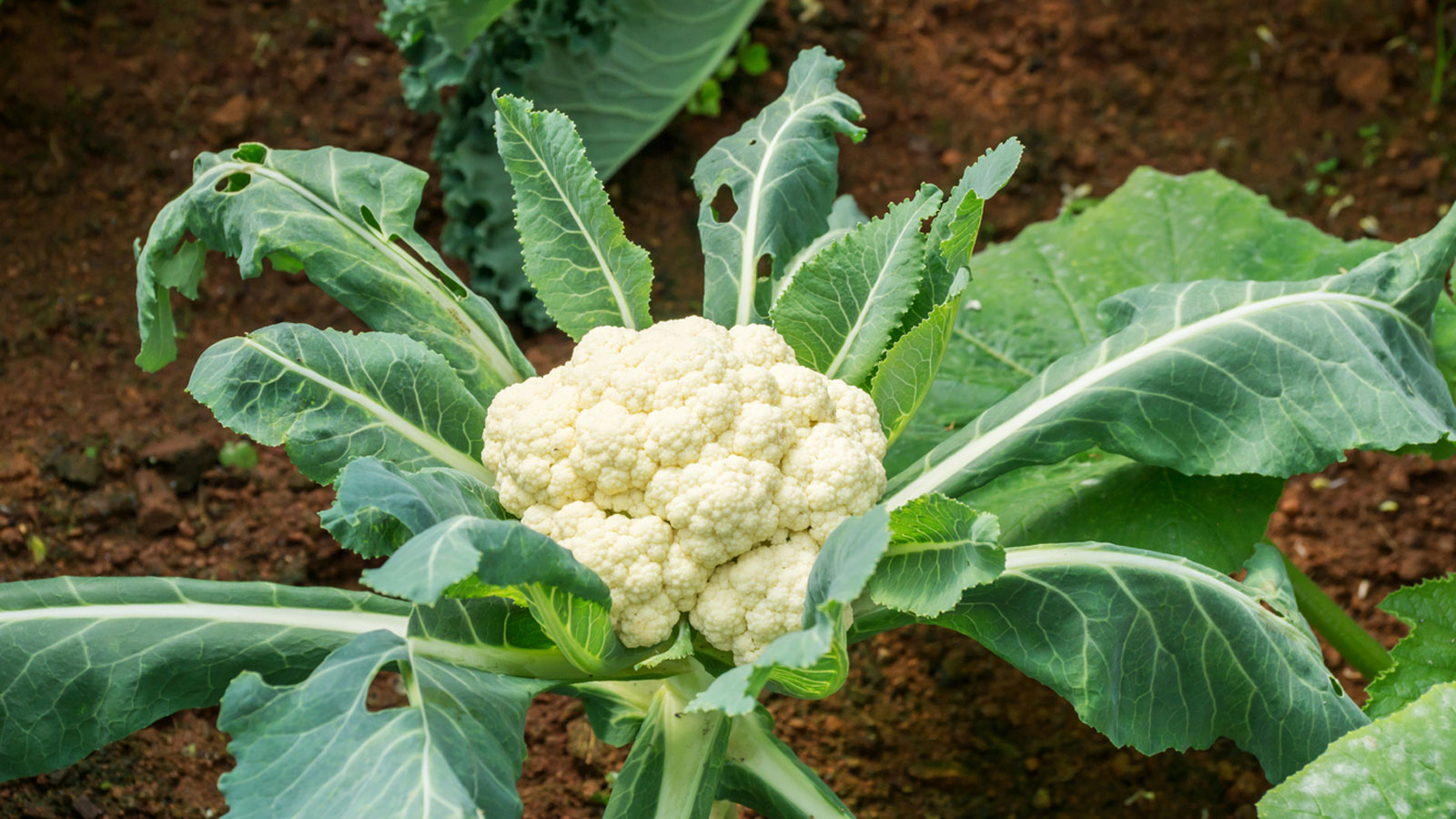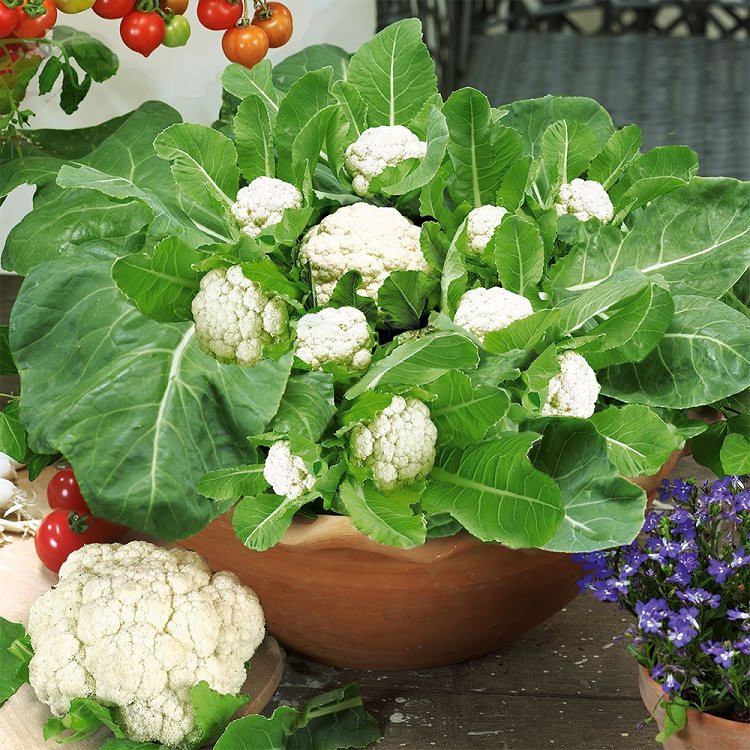
Cauliflower is a sun-loving, cool-season crop that is produced in the spring and fall. Because it does not withstand heat or cold, it can be a fickle garden plant, thus it is not recommended for novices unless you enjoy a challenge. Learn how to grow cauliflower in your house, garden, or nursery and how to care for it.
Cauliflower Charecteristic
| Botanical Name | Brassica oleracea |
| Plant Type | Vegetable |
| Sun Exposure | Full Sun |
| Soil Type | Frank |
| Soil pH | Slightly Acidic to Neutral |
| Flowering Time | Spring |
| Flower Color | White |
| Climate / Temperature | 15 to 22 ° C |
Planting Cauliflower
- The soil must be very high in organic matter, and the bed should be covered with a mixture of aged manure and/or compost.
- Cauliflower requires additional nutrients as well. Use a fertilizer with a 5-10-10 ratio. To keep heads from “buttoning,” fertile soil maintains moisture.
- Cauliflower should be started from small nursery plants rather than seeds.
- Start sowing cauliflower seeds 4-5 weeks before the last spring frost date. Sow cauliflower seeds 7 to 15 inches apart and up to 12 inches deep in rows 7 to 15 inches apart. During germination and growth, make sure to keep the plants well hydrated.
- Seedlings (or small nursery plants) should be transplanted 2 to 4 weeks before the last spring frost date, not before or after.
- Cauliflower plants should be spaced 40 to 60 centimeters apart, with 1 meter between rows.
- Prepare to protect plants from frost in the early spring by covering them with old milk bottles if required. Extreme cold can stifle growth and/or prevent buds from forming.
- Plant a fall crop 6 to 8 weeks before the first fall frost date, but when daytime temperatures have consistently dropped below 24 degrees Celsius. If necessary, provide shade to protect plants from the sun.
- Mulch helps to keep moisture in the soil.
Cauliflower Care
- Any halt in the growth of the cauliflower plant can be harmful. Temperature, humidity, soil nutrition, and insects are all factors that might lead plants to develop a head early or damage an existing one.
- Water at least twice a week with 2 inches of water; even with normal rains, this frequently necessitates additional watering.
- Cover the plants with a high nitrogen fertilizer 3-4 weeks after transplanting for the best results.
- Remember that the cauliflower will begin as a loose head and will take time to fully form. Many types need 75 to 85 days to mature after being transplanted. Wait patiently!
-
A boron shortage in the soil is indicated by brown heads. 1 tablespoon of borax dissolved in 1 gallon of water (Avoid boron from entering other plants.) Alternatively, give liquid seaweed extract right away and repeat every two weeks till symptoms go away. More compost should be added to the soil in the future.
-
Pink hedges in white kinds can suggest too much sun exposure or temperature variations. Stress or low soil fertility could cause purple tints.

Irrigation (Water)
Cauliflower demands consistent wetness, so don’t overdo it. Make a narrow moat around each plant by heaping earth on a ridge around it to promote moisture retention. Mulch this ridge of soil to help with moisture retention, protect sensitive roots, keep the soil cool, and keep weeds at bay. Because the roots are shallow and brittle, the less weeding you do, the better.
Once a week, water deeply over the roots with a gentle spray nozzle directed at the soil. When the weather is colder, do this in the morning or evening. Hand watering along with rainfall should total one to two inches each week.
Temperature Management
The majority of your cauliflower crop will likely be in full sun in the early spring; however, as the season progresses, the trees begin to emerge and cast some shadow.
When selecting a planting location, keep this in mind. If you don’t have access to partial shade, stock up on lightweight floating row covers that you can swiftly deploy if the sun’s rays get too fierce. To guarantee enough air circulation, stack them as high as possible and leave the ends of the rows uncovered.
The converse is true for fall crops. Row covers made of thicker material should be kept on hand in case of a cold snap. To create a pleasant ambiance, place them a little lower and close the ends. When the temperature rises, make careful to open the ends or remove them completely.
Row covers, in addition to providing some temperature control, also serve to keep pests at bay.
Pests and Diseases in Cauliflower Growing
- Aphids
- Black rot
- Luggage loopers
- Cabbage root worms
- Cabbage Worm: The nectar of dwarf zinnias attracts ladybugs and other predators that help protect the cauliflower from cabbage worms.
- Clubroot
- Powdery mildew
- Bedbugs
- Trips
- White oxide
Cauliflower Harvesting
- Plants are normally ready to harvest 50 to 100 days from seed germination, or 7 to 12 days after blanching, depending on the cultivar.
- It’s time to harvest the heads when they’re compact, white, and solid. The heads should reach a diameter of 6 to 8 inches in the ideal situation.
- Using a large knife, cut the plant’s heads off. Make sure some of the leaves are left around the head to protect it.
- If the heads are too small yet have begun to open, they will not improve and should be picked as soon as possible.
- If the cauliflower appears rough, it is past its prime and should be discarded.
Cauliflower Storage
- Refrigerate the heads in an airtight plastic bag. They should last a week or so.
- You can also freeze or pickle the heads for long-term storage. Cut into 1-inch pieces to freeze. 3 minutes of blanching in gently salted water Cool for 3 minutes in an ice bath, then drain and wrap. Seal and freeze.






